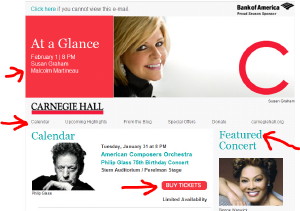Best Practices for Emailing in the Arts
By Christopher Gruits
April 2, 2012
 You probably are using email as one of the main ingredients in your marketing mix to increase ticket sales, let your audience know about upcoming events and maintain contact with your customers. According to successful email marketers, the key is to keep a firm eye on your email strategy and plan, adhere to the general best practices, and choose a group of metrics to closely track, and guide your email activities. In summary:
You probably are using email as one of the main ingredients in your marketing mix to increase ticket sales, let your audience know about upcoming events and maintain contact with your customers. According to successful email marketers, the key is to keep a firm eye on your email strategy and plan, adhere to the general best practices, and choose a group of metrics to closely track, and guide your email activities. In summary:
- 1. Keep designs simple, cut unneeded copy, include strong calls-to-action (CTAs) and spend as much time writing your subject lines as the rest of your email copy.
2. Test everything: the day and times for sending, which subject lines get better responses, which offers work and then ruthlessly adjust your efforts accordingly.
3. Focus on the key data: deliverability, open rates, click-through rates and ultimately, and most importantly, conversion rates.
4. Make messages part of a series, not just one-offs. Map out a schedule of messages to deepen engagement over the long-term once you have acquired new email addresses.
5. Explore Google's e-commerce tracking for your website and tag your emails to use this system. This is how you'll be able to track conversions.
Structuring your messages
Make sure you have a firm handle on the design elements you are using to define your brand wherever it digitally lives—your website, emails, mobile app, social media pages, etc.—so the look is consistent across these platforms. These elements include your logo, colors, font, general layouts (tightly packed or lots of white space, for instance. Also create a "voice" for your efforts. (Are you casual or formal? Do you personalize by "speaking" in the first person?) Make these a part of your marketing approach and carrying them through your email messages.
- Maintain a consistent voice and brand experience. Color, font and layout need to closely align with other promotional materials
- Users should have a visually seamless experience when moving from an email to your organization's website
- Make sure that the "sweet spot" of your message—the upper left hand corner—has your most compelling CTA

- In many email programs—for instance, Microsoft Outlook—only a portion of your content is visible to the recipient, in this case, it opens in the preview pane.
The top half of the email (before the scroll) should grab a recipient's attention with a bold image or headline.
Note the prioritization of the Graham/Martineau concert promoted in red box, and the 'Featured Concert tout on the right.
Writing for Email
Keep it short and sweet. Remember, you only have a few seconds to get your audiences' attention and their inbox is full of other emails
- Don't fill your emails with large amounts of copy. Think of an email message as an extended headline
- Avoid listing all performance details when possible
- Focus on your key message, such as performer, time and place
- Think of email as a "hook" to drive people to a place where they can take an action, such as read extended biographies or program notes, experience audio or video, or purchase tickets or donate
Improving Open Rates
Subject lines and the sender's name are key to open rates. Whole books have been written about email subject lines, while the best practice for the sender's name is pretty simple.
- Subject lines: Clear and informative works best, as opposed to clever and glib. Exclamation points and all-capital letters will trigger Spam filters
- Recipients are more likely to open an email if they know the sender, so always use the organization's name or a key staff member's name. Also, you'll be sure to comply with the CAN-SPAM Act .

Timing and Testing
Timing is everything, and especially in email marketing. Every audience is different and the best way to determine an optimal delivery schedule is to test send times specifically with your own list. This can help to ensure that your next email achieves a higher open rate.
- Split your email delivery into two groups; one group receives an email in the morning, let's say 7am, and the second group receives an email in the afternoon, perhaps at 4pm. Not all email is delivered instantaneously. You should allow enough time for delivery within an hour of your target time
- Consider testing send times for different types of email, too. Targeted sales blasts might have varying open rates depending on when they are sent, while regular newsletters should be sent according to a standardized day and time
- Consider re-sending messages after the initial delivery. For instance, if a 20% open rate is achieved, it may be worth re-sending the same email with a different subject line a week later, to garner more opens and eventually conversions
In the U.S., arts organizations usually consider a 20% open rate as standard. In the U.K., arts organizations typically achieve a 30% open rate, but they tend to send less frequent email communications. Email Acquisition & Follow Up
An email database is one of the most valuable assets a company possesses and it needs to be treated with care.


- A website should have a clear CTA for sign-up on every page. Other platforms, such as Facebook, etc., should provide a link to sign up
- Consider offline opportunities for collection of names/email addresses
- Phone sales, walk up and in-house messaging such as signs in the lobby, encouraging users to "Sign up for our e-newsletter to receive special discounts and offers" or inserts in the program are also options
- At Carnegie Hall, we often use space in the Playbill to remind audiences of online content and information they'll access by signing up to our e-newsletter
- Many organizations focus on click-through rates. It's worth considering that a more valuable outcome in measuring the effectiveness of a banner ad, for example, may be the acquisition of a user's email address
Many organizations conduct contests and special offers to encourage sign-ups. Below are some methods for utilizing the newly captured data to drive future conversions.
List Management
A tiered engagement strategy is used most effectively by starting with a value-added offer or piece of content. Offering people something is a good way to welcome a new sign-up. Then, based on response you can offer a single ticket or special promotion. At each step you are furthering engagement and moving the user down the path to a full-priced sale, donation or other type of purchase.
A possible communications path to welcome a new user might look like this
- After sign up, user receives an auto reply welcome message with links to video or 'About Us' information
- One week later, user receives a special discount or free give-away message
- One month later, user receives a content message promoting a video or blog post
- Two months later, user receives a customized single ticket offer or special promotion such as a free download of a recording or coupon toward a piece of merchandise.
This method takes time and patience—you'll only convert a small percentage of the total list you acquired.
- Develop a detailed calendar listing of each communication
- Coordinate between ticket sales and fundraising appeals
- Map out each step in the communication path and include all channels.
- Phone, direct mail, and e-communications are all part of the mix and determining the optimal timing between all of these channels is crucial.
Measuring Response
First, your email program should tell you the obvious statistics such as open rates, click-through rates, unsubscribes and bounce rates. Measuring the open rate is important: tracking a decline in opens might prompt an adjustment in the send time or subject line, which, through testing, can be improved. Another method for tracking revenue and integration with a website is through Google Analytics (GA) and Google's e-commerce tracking. Erik Gensler of Capacity Interactive provides a detailed description of this on his blog. Attaching GA tracking tags to emails will provide data on actual sales, what pages produce the most revenue and how individual emails are performing. Google provides a good blog on implementation and for e-commerce tracking it's best to work with a programmer to ensure the correct set up. Detailed information on e-commerce tracking is provided here, and is well worth exploring.  Christopher Gruits is the Director of e-Strategy at Carnegie Hall, guiding all digital content and messaging across web, email, mobile, social media, and video. He is the creator of the web's first "Digital Composer in Residence" with the London Sinfonietta and has managed orchestra and artistic operations with the Seattle Symphony Orchestra.
Christopher Gruits is the Director of e-Strategy at Carnegie Hall, guiding all digital content and messaging across web, email, mobile, social media, and video. He is the creator of the web's first "Digital Composer in Residence" with the London Sinfonietta and has managed orchestra and artistic operations with the Seattle Symphony Orchestra.
Copyright © 2025, Musical America